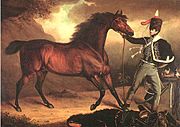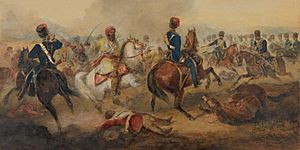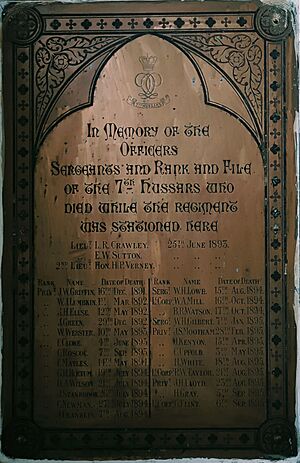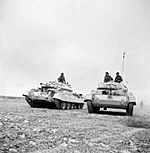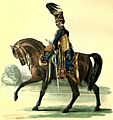7th Queen's Own Hussars facts for kids
Quick facts for kids 7th Queen's Own Hussars |
|
|---|---|
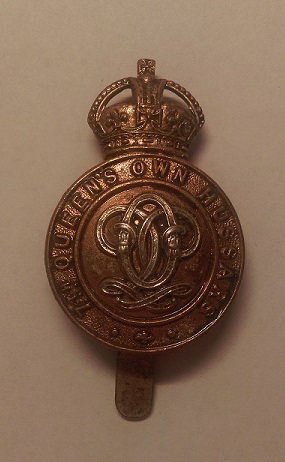
Crest and tie colours of the 7th Hussars
|
|
| Active | 1689–1714 1715–1958 |
| Country | |
| Branch | Army |
| Type | Cavalry of the Line/Royal Armoured Corps |
| Role | Light Cavalry |
| Size | one regiment |
| Nickname(s) | The Saucy Seventh/The Lilywhite Seventh |
| Motto(s) | Honi soit qui mal y pense (French, Evil Upon Him who Evil Thinks) |
| March | (Canter) The Campbells Are Coming (Quick) Bannocks o'Barley Meal (Slow) The Garb of Old Gaul |
| Anniversaries | Waterloo Day |
| Commanders | |
| Notable commanders |
Field Marshal Earl Haig |
The 7th Queen's Own Hussars was a special cavalry regiment in the British Army. It was first created in 1689. This regiment served for over 250 years, fighting in major conflicts like the First World War and the Second World War. In 1958, it joined with another regiment, the 3rd The King's Own Hussars, to form the Queen's Own Hussars.
Contents
History of the 7th Hussars
Starting Years: The 17th Century
In April 1689, several groups of Scottish horse soldiers were formed. This was a quick response to a rebellion happening in Scotland. By December 1690, these groups became two regiments. One was led by Colonel Richard Cunningham. It was known as Cunningham's Regiment of Scots Dragoons.
In 1694, the regiment moved to Flanders (modern-day Belgium). There, they helped in the Siege of Namur in 1695. This was a big battle to capture a city. After this, most countries involved in the Nine Years War were tired and low on money. So, there wasn't much fighting. In 1696, Colonel Cunningham was promoted. Lord Jedburgh took over, and the regiment became Jedburgh's Regiment of Dragoons.
Battles of the 18th Century
For most of the War of the Spanish Succession (1702-1714), the regiment stayed in Edinburgh, Scotland. In 1709, William Kerr became the new leader.
In 1711, Kerr's Dragoons joined the main army in Flanders. But the war was ending. The regiment was disbanded in 1714. However, it was brought back in July 1715 by King George I. It was renamed HRH the Princess of Wales's Own Royal Regiment of Dragoons to honor Princess Caroline. During the Jacobite rising of 1715, they fought at Battle of Sheriffmuir. This was their only big battle until 1743. After King George II was crowned in 1727, the regiment was renamed The Queen's Own Royal Regiment of Dragoons.
The unit went back to Flanders in 1742 during the War of the Austrian Succession. They fought in several important battles: Dettingen, Fontenoy, Rocoux, and Lauffeld in 1747. The war ended in 1748, and the regiment returned to England.
When the Seven Years' War started in 1756, the regiment took part in raids. In June 1758, they helped burn 100 enemy ships in St Malo. They also participated in the Raid on Cherbourg in August 1758 and the Battle of Warburg in July 1760. In 1783, they became 'light dragoons'. These were fast cavalry used for scouting. Their name changed to the 7th (The Queen's Own) Regiment of (Light) Dragoons. During the French Revolutionary Wars, they fought at Beaumont in April 1794 and Willems in May.
Adventures in the 19th Century
In 1807, the regiment became Hussars, a type of light cavalry known for their fancy uniforms. They were renamed 7th (The Queen's Own) Regiment of (Light) Dragoons (Hussars). In October 1808, they went to Spain to help Sir John Moore's army retreat. They fought bravely at the Battle of Sahagún and Battle of Benavente. Sadly, a ship carrying some of the Queen's Own Hussars sank in 1809, and many soldiers were lost.
The unit returned to the Peninsular War in August 1813. They made several charges at the Battle of Orthes in February 1814. Wellington, the famous general, said the 7th Hussars "distinguished themselves" and captured many prisoners.
In March 1814, the unit moved to Brighton, England. They helped stop riots caused by new laws about grain prices. When Napoleon returned to power in 1815, the regiment went to the Netherlands. They fought in a rearguard action at Genappe on June 17. The next day, at the famous Battle of Waterloo, the regiment was kept in reserve. But in the evening, they made many charges. A lieutenant from the 7th Hussars, Standish O'Grady, wrote that they charged "twelve or fourteen times."
In May 1838, the regiment was sent to Canada to help with the Lower Canada Rebellion.
The Indian Mutiny
In late 1857, the regiment went to India to help put down the Indian Rebellion of 1857. Cornet William Bankes died fighting bravely in March 1858. Major Charles Fraser saved three soldiers who couldn't swim from a river in December 1858.
In 1861, the regiment's name was shortened to the 7th (Queen's Own) Hussars.
The regiment sent soldiers to the Nile Expedition in 1884. In November 1901, they went to South Africa during the Second Boer War.
The First World War
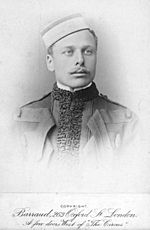
At the start of the First World War, the regiment was in Bangalore, India. In November 1917, they arrived in Mesopotamia (modern-day Iraq) as part of the 11th Indian Cavalry Brigade. They fought in the action of Khan Baghdadi in March 1918 and the Battle of Sharqat in October 1918.
After the war, in 1921, the regiment was simply called 7th Queen's Own Hussars. In 1939, they switched from horses to tanks and became part of the Royal Armoured Corps. They were given Mark II tanks.
The Second World War
The regiment had been trained with tanks since 1937. They were in Cairo, Egypt, when Italy joined the war in June 1940. They were part of the 7th Armoured Brigade in the famous 7th Armoured Division, known as the "Desert Rats." On June 14, 1940, the 7th Hussars captured Fort Capuzzo. They also fought in the Battle of Sidi Barrani in December 1940 and the Battle of Bardia in January 1941.
Hitler sent General Erwin Rommel and his Afrika Korps to help the Italians. In April 1941, Allied troops in Tobruk were surrounded. But in June 1941, the 7th Armoured Division was ready to fight again. Rommel then pushed the Allies back into Egypt. The regiment helped slow Rommel's advance, but their commanding officer and many others were killed at the Battle of Sidi Rezegh in November 1941.
In January 1942, the regiment was sent to Burma and fought the Japanese Army at Pegu. Field Marshal Sir Harold Alexander praised the regiment, saying, "Without them we should never have got the Army out of Burma."
The regiment had to destroy its tanks when crossing the Chindwin River in May 1942. They then moved to the Italian Front. There, they fought with the Polish 2nd Corps at the first Battle of Ancona in June 1944 and in the battles for the Gothic Line in autumn 1944. The Polish Army honored the regiment for their "Magnificent work – fine examples of heroism and successful action."
The regiment reached Bologna in October 1944 and then fought in the battle for the Po plains in the spring of 1945.
After the Wars
After the Second World War, the regiment was stationed in Soltau, Germany, in June 1946. They returned to the UK in December 1947. They then moved back to Germany in 1949 and 1951. In 1954, the regiment was sent to Hong Kong and came home in 1957.
Even though many military forces were reduced after the war, the 7th Hussars survived for a while. But in 1957, it was decided they would join with another regiment. So, in 1958, the 7th Queen's Own Hussars combined with the 3rd The King's Own Hussars to form the new Queen's Own Hussars.
Regimental Museum
The collection of items from the regiment is moving to a new place in Warwick called "Trinity Mews." It was planned to open in 2019.
Battle Honours
Battle honours are special awards given to military units for their bravery and success in battles. Here are some of the battles the 7th Hussars were honored for:
- Early wars: Dettingen, Warburg, Beaumont, Willems, Orthes, Peninsula, Waterloo, Lucknow, South Africa 1901-02
- The Great War: Khan Baghdadi, Sharqat, Mesopotamia 1917-18
- The Second World War: Egyptian Frontier 1940, Beda Fomm, Sidi Rezegh 1941, North Africa 1940–41, Ancona, Rimini Line, Italy 1944–45, Pegu, Paungde, Burma 1942
Victoria Crosses
The Victoria Cross is the highest award for bravery in the British military. Two members of the 7th Hussars received this honor:
- Lieutenant General Sir Charles Craufurd Fraser
- Cornet William George Hawtry Bankes
Images for kids
See also




